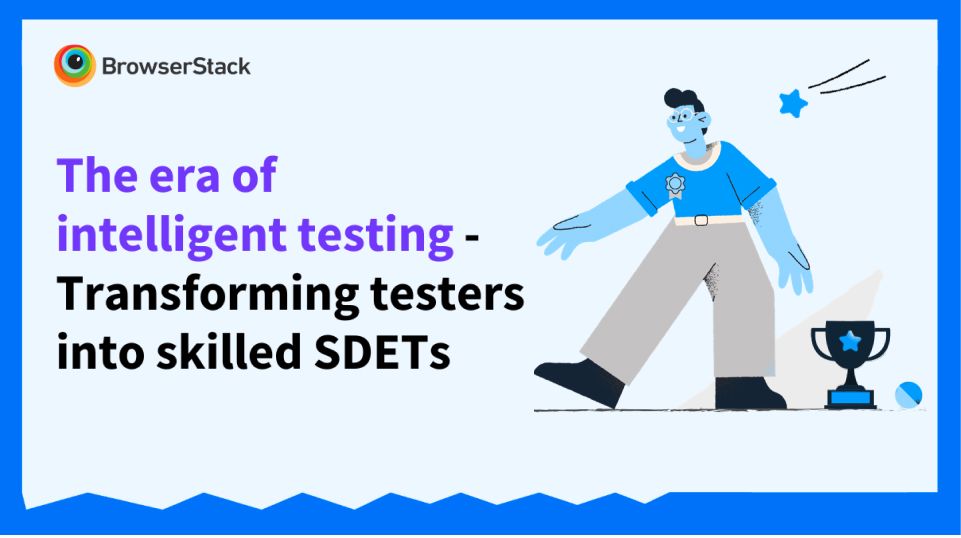
With ever-increasing testing requirements and ever-shrinking release velocities, companies must constantly improve their ability to test at scale. This has led to SDETs becoming increasingly influential as they bridge the gap between being agile and delivering quality applications.
However, companies must implement scalable QA strategies and upskill testers to enable QA to deliver quality at scale. Though critical to long-term success, this is often overlooked as the focus shifts to putting out short-term fires.
BrowserStack hosted the webinar - The era of intelligent testing where Siddhant Wadhwani shared valuable insights on transforming test teams. Siddhant Wadhwani is a versatile, self-directed leader with 7 years of professional work experience in the IT industry. He plays a key role in implementing best practices and a Testing Center of Excellence (TCoE) across multiple product lines at Newfold Digital.
Here is how your test organization can increase QA output, improve collaboration, and upskill testers by building scalable testing practices and developing a talent pool within testers:
1. Transform testers into SDETs
An organization can take one of the following six approaches while transforming testers into SDETs. It is imperative to identify the current stage of your test organization and progress to the subsequent stages-
Stage 1 - Reactive Approach
At this stage, organization does not invest in building a dedicated team of testers and assumes developers would handle the testing. Minimal formalized processes & tools, limited test automation, and no dedicated testing team are the identifiers of a reactive test organization.
Stage 2 - Proactive Approach
At this stage, a small team of testers is formed. Coding standards & best practices are followed, and there is a shifting focus toward test automation with streamlined test environments.
Stage 3 - Strategic Approach
Test teams leverage extensive tools or frameworks at this stage. There is increased focus on test management, using Zephyr for JIRA, and factors like incident management and root cause analysis are looked on.
Stage 4 - Shift-Left Approach
The characteristic features of this stage include in-sprint automation testing (UI & API), shift towards left, and a focus on test-driven development. Skilled SDETs are required at this stage.
Stage 5 - DevOps Approach
At this stage, continuous testing (CI/CD) is adapted. Characteristic features include doctored tests, debug logs & performance monitoring. SDET team upskilling is required at this stage.
Step 6 - Cognitive Approach
There is a mindset switch to non-functional areas like low code, no code automation and service virtualization at this stage.
2. Define the ideal test strategy
A test strategy depends on factors like:
- Types of applications
- Tech stack
- Project requirements
- Team size & business need
For picking the ideal test strategy for your organization, focus on unit testing & component-level testing as the first step in your test organization’s transformation. While reaching maturity, implement integration testing to provide rapid feedback on incorporating small changes. At last, make use of E2E (end-to-end) testing when your testers have become skilled SDETs. However, E2E testing tends to be a problem as its costly to implement and maintain.
3. Set up a Test Center of Excellence (TCOE) with a quality-first approach
The steps for setting up a TCOE in your testing organization are as follows-
- Analyze your business goals, priorities, and challenges using SWOT analysis
- Standardize the test processes, set best practices, and set up metrics for measuring performance
- Synergise with teams to align with business goals with a focus on quality
- Expand your expertise by sharing learnings across other business units to improvise strategies
- Track and measure ROI (return on investment) using dashboards. Some of the essential metrics for quality assurance include Bug efficacy, Bugs reported, Bugs resolved, Open bugs, Duplicate/unreproducible/rejected/abandoned bugs, Lead time, Deployment frequency, Change failure rate, and Mean time to restore.
4. Unlearn legacy & learning developmental models for team up-skilling
Quality assurance has seen tectonic shifts in tools and processes. Unlearning the legacy and keeping up with new developmental models are necessary for transforming your test organization.
While many learning models are available and used by organizations in their transformational journey, the ‘70-20-10 learning model’ can be a good starting point for your team. Learning initiatives can be categorized into experiential, social/peer-to-peer learning, and formal learning, with each contributing 70, 20, and 10 per cent respectively in the overall learning.
5. Choose what’s best for your team
- Identify & recognize the team’s strengths and weaknesses.
- Give & receive constructive feedback effectively
- Communicate openly, define ‘SMART’ goals, delegate & trust
Equipped with these techniques, your test organization can transform into a highly efficient unit providing excellent output at scale.
Watch our webinar for more details:
About BrowserStack
Founded in 2011, BrowserStack is a privately held company backed by Accel, Bond, and Insight Partners. We are the world’s leading software testing platform powering over two million tests every day across 19 global data centers. Our 50,000 customers include Tesco, Shell, NVIDIA, and Discovery rely on our platform that provides instant access to 3,000+ real mobile devices and browsers on a highly reliable and scalable cloud infrastructure. With BrowserStack, Dev and QA teams can move fast while delivering an amazing experience for every customer.
For more information, visit https://www.browserstack.com.
